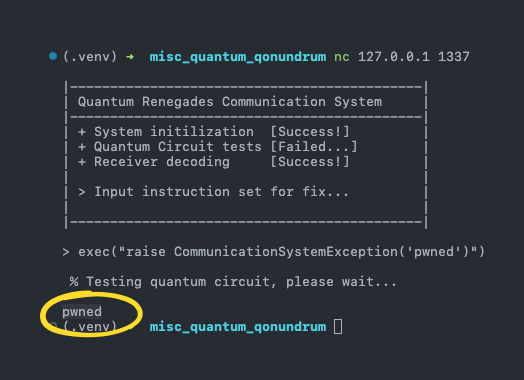Quantum Conundrum
This was my first quantum-related CTF challenge which I was hoping to use
quantum computing concepts to solve. The intended solution required one to
implement a quantum teleportation algorithm, which I could not comprehend and
ended up exploiting an insecure eval to achieve RCE.
Description
KORP™, the heartless corporation orchestrating our battles in The Fray, has pushed us to our limits. Refusing to be a pawn in their twisted game, I’ve learned of a factionless rebel alliance plotting to dismantle KORP™. While it may sound like mere whispers, there’s a chance it holds truth. Rumors suggest they’ve concealed a vital communication system within The Fray, powered by cutting-edge quantum computing technology. Unfortunately, this system is reportedly malfunctioning. If I can restore this communication network, it could be the key to toppling KORP™ once and for all. However, my knowledge of quantum computing is limited. This is where you come in! As I infiltrate The Fray to access the system, I’ll rely on your expertise to identify and repair the issue. Are you up for the challenge? Together, we can make a difference in this battle against oppression.
The source code for the challenge can be found here , or on HackTheBox’s Github.
Challenge Overview
This challenge takes in a user’s input and parses it into either a Hadamard
or CNOT gate, and appends it to a quantum circuit that is then executed on a
Qiskit runner. The user input should be a dict containing 2 keys, type and
register_indexes, as directed by communication_system/instructions_set.py.
A circuit is constructed with the 0th qubit initialized to a random value, and the grey area/dotted line shown below is populated with the user’s inputs.

Getting the Flag
TODO: Write about the solve condition
Intended Solution
The intended solution requires the user to make use of these gates to construct a quantum teleportation algorithm. It makes use of the Hadamard and CNOT gates to entangle the qubits together, allowing for a state to be “copied” to another qubit. This Jupyter notebook does a great job of explaining the details and contains working snippets of code to “teleport” the qubit state in Qiskit.

We do a Little Pentesting
When doing research for post-quantum cryptography for an assignment I had a few months back, I came across this theorem called the no-cloning theorem. It basically states that any quantum state cannot be cloned and thus no two qubits can be identical. The quantum teleportation algorithm violate this theorem as it “destroys” the state of one qubit before “copying” it to another.
Since the way to grab the flag was to somehow “clone” the state of the first qubit into the second, I thought that this was impossible and maybe it was just a deep rabbit hole (In hindsight, this rabbit hole seems a little too deep). Thus, I went on a journey to look for other attack vectors.
Hey Ma, Look an Eval Function
While poking around at the code, I realized that the commands (or dictionaries)
were parsed using an eval function with some safeguards. It checks if the
keys register_indexes and type exists, and limits the register_indexes
based on how many gates a type accepts.
As there were no blacklists for command injection implemented for this
eval function, I realized that this could be exploited to gain remote
code execution.
Attempted Eval Exploitation
In a locally deployed testing environment, I uploaded a simple
__import__("os").system("cat secret.py") and it worked flawlessly.
However, it only printed to the console running the server, and not the
socket connection that I was using to interface with the challenge.
In other words, nothing was returned on my screen, other than an error
message complaining that my command was not in a proper format.

Thankfully, the server gives us a nice gadget to send any output back to the client.
This part of the server allows us to raise a CommunicationSystemException with a
custom payload, such as raise CommunicationSystemException("pwned"), and the
payload should be echoed back to the client.
However, eval only allows us to run expressions
, which can be thought of as anything on the right of an = sign.
Using x = 3 + 2 as an example, the expression would be 3 + 2.
Since we are inside a eval, if we directly try to raise a
CommunicationSystemException, it would be invalid as
x = raise Exception() is not a valid statement in Python.
Actual Eval Exploitation
Thankfully, we can circumvent this by wrapping our code inside an exec function.
Since exec returns something, x = exec("...") is a perfectly valid statement
in Python. Let’s combine the exception gadget and this exec block to try and
get the server to echo back a payload.

Nice! Now we can issue an os command to read secret.py and raise a
CommunicationSystemException with the content of secret.py! Since
os.system does not return the output of the process
, we can use os.popen('cmd').read() instead.
Final payload:

Flag: HTB{4lways_us3_a_b3ll_4_t3leportat1on}